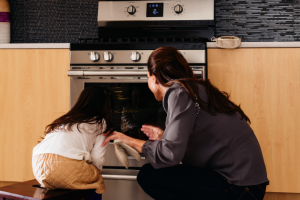Check Your Oven Temperature
Precise temperatures are vital to baking, but just because your oven display shows 300ºf it doesn’t mean this is the case. Ovens can run cool or hot by as much as 30ºf, which can have a massive impact on your baking. If your oven is miscalibrated and is heating to 270ºf instead of 300ºf, your bread, pie or cake will not only take longer to bake, but will have a different texture and taste.
To check your oven temperature, use an oven safe thermometer on the center rack and take a couple of temperature readings. Oven temperatures cycle up and down, so take several readings over a 15 minute period. If your oven doesn’t allow you to calibrate your display, you’ll need to remember to accommodate any temperature difference when you set the dial.
Eliminate Build-up
Build-up can not only compromise efficiency, but can also affect the consistency of temperatures and overall performance. To eliminate this build-up, you should clean your oven thoroughly at least once or twice a year. Many ovens feature a self-cleaning function, making cleaning very easy. You’ll need to follow the manufacturer’s guidelines in your owner’s manual for the safe use of this function. You should open a window to increase ventilation and ensure that you stay at home while you’re cleaning the oven. You’re likely to notice that the kitchen gets warmer during cleaning, so keep a close eye on your oven to ensure that it is safe.
To minimize the need for cleaning, try to avoid batter, juices and other materials dripping into the bottom of the oven. Place cake tins and casserole dishes on a cookie sheet to catch anything that may overflow. Avoid blocking the vents at the bottom of your oven by trying to line the oven with foil. This can not only create ventilation issues, but it can also create an insulation barrier that affects the internal temperature and causes hot spots.
Set Your Oven Racks
When you’re not regularly baking, it can be very easy to rearrange your oven racks to simply fit more dishes. While many dishes can be adequately prepared at any position in your oven, proper oven placement is vital for baking. For most baked items, the center of the oven is the optimum position, so you should ensure that your racks are set correctly.
Address Any Other Problems
Even the best ovens can have common issues that compromise performance. Whether you have a broken oven coil, a loose knob or even moisture forming on the outside of the oven door, it is important that you don’t ignore the issue. These seemingly minor issues can compromise your oven performance and could create problems with your baking. If there are any mechanical or loud noises emitted from your oven, you should discontinue use immediately. An experienced home appliance expert repair specialist will assess your oven to diagnose any problems and provide you with any necessary repairs.
If you’re still having some difficulties with your oven, you can rely on professional home appliance repair technicians for a long-lasting, effective solution. For help will all your oven repair needs, ensure you speak to a professional appliance repair service.
